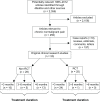Long-term opioid treatment of chronic nonmalignant pain: unproven efficacy and neglected safety?
- PMID: 23874119
- PMCID: PMC3712997
- DOI: 10.2147/JPR.S47182
Long-term opioid treatment of chronic nonmalignant pain: unproven efficacy and neglected safety?
Abstract
Background: For the past 30 years, opioids have been used to treat chronic nonmalignant pain. This study tests the following hypotheses: (1) there is no strong evidence-based foundation for the conclusion that long-term opioid treatment of chronic nonmalignant pain is effective; and (2) the main problem associated with the safety of such treatment - assessment of the risk of addiction - has been neglected.
Methods: Scientometric analysis of the articles representing clinical research in this area was performed to assess (1) the quality of presented evidence (type of study); and (2) the duration of the treatment phase. The sufficiency of representation of addiction was assessed by counting the number of articles that represent (1) editorials; (2) articles in the top specialty journals; and (3) articles with titles clearly indicating that the addiction-related safety is involved (topic-in-title articles).
Results: Not a single randomized controlled trial with opioid treatment lasting >3 months was found. All studies with a duration of opioid treatment ≥6 months (n = 16) were conducted without a proper control group. Such studies cannot provide the consistent good-quality evidence necessary for a strong clinical recommendation. There were profound differences in the number of addiction articles related specifically to chronic nonmalignant pain patients and to opioid addiction in general. An inadequate number of chronic pain-related publications were observed with all three types of counted articles: editorials, articles in the top specialty journals, and topic-in-title articles.
Conclusion: There is no strong evidence-based foundation for the conclusion that long-term opioid treatment of chronic nonmalignant pain is effective. The above identified signs indicating neglect of addiction associated with the opioid treatment of chronic nonmalignant pain were present.
Keywords: addiction; chronic pain; neuropathic pain; opioids; overdose death; quality of evidence; treatment efficacy.
Figures
References
Supplementary materials
List of articles on long-term opioid treatment of chronic nonmalignant pain (1983–2012)
-
- Adams EH, Breiner S, Cicero TJ, et al. A comparison of the abuse liability of tramadol, NSAIDs, and hydrocodone in patients with chronic pain. J Pain Symptom Manage. 2006;31:465–476. - PubMed
-
- Adams LL, Gatchel RJ, Robinson RC, et al. Development of a self-report screening instrument for assessing potential opioid medication misuse in chronic pain patients. J Pain Symptom Manage. 2004;27:440–459. - PubMed
-
- Adams NJ, Plane MB, Fleming MF, Mundt MP, Saunders LA, Stauffacher EA. Opioids and the treatment of chronic pain in a primary care sample. J Pain Symptom Manage. 2001;22:791–796. - PubMed
-
- Alexander GC, Kruszewski SP, Webster DW. Rethinking opioid prescribing to protect patient safety and public health. JAMA. 2012;14(308):1865–1866. - PubMed
-
- Alford DP. Opioids for chronic pain in patients with substance abuse: too much, too little or just right? Pain. 2009;145:267–268. - PubMed
References
-
- Chalmers TC, Smith H, Jr, Blackburn B, et al. A method for assessing the quality of a randomized control trial. Control Clin Trials. 1981;2(1):31–49. - PubMed
-
- Evidence-Based Medicine Working Group Evidence-based medicine. A new approach to teaching the practice of medicine. JAMA. 1992;268(17):2420–2425. - PubMed
-
- McQuay H, Moore A. An Evidence-Based Resource for Pain Relief. Oxford; Oxford University Press; 1998.
-
- Loeser JD.Five crises in pain management Pain Clinical Updates 20122011–4.Available from: http://www.iasp-pain.org/AM/AMTemplate.cfm?Section=HOME,HOME&CONTENTID=1...Accessed June 6, 2013
LinkOut - more resources
Full Text Sources
Other Literature Sources
Miscellaneous


